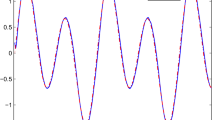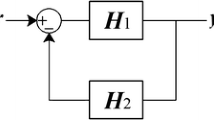Abstract
Because the nonlinear relationship between the input and output generally exists in many actual systems. In this paper, a new design method of direct adaptive fuzzy controller is proposed for this class of SISO nonlinear systems. The adaptive law and constraint conditions of the system parameters are given in this study. The stability of the closed-loop system is proved with all state variables being uniformly bounded in the Lyapunov sense. Additionally, the convergence of the fuzzy control system is analyzed. Finally, the simulation results obtained for the practical example show the feasibility, effectiveness and widely use of the designed method.










Similar content being viewed by others
References
Tong, S.C., Li, Y.M., Sui, S.A.: Adaptive fuzzy tracking control design for SISO uncertain nonstrict feedback nonlinear systems. IEEE Trans. Fuzzy Syst. 4(6), 1441–1454 (2016)
Tong, S.C., Li, Y.M., Sui, S.A.: Adaptive fuzzy output feedback control for switched nonstrict-feedback nonlinear systems with input nonlinearities. IEEE Trans. Fuzzy Syst. 24(6), 1426–1440 (2016)
Gao, Y., Tong, S.C.: Composite adaptive fuzzy output feedback dynamic surface control design for uncertain nonlinear stochastic systems with input quantization. Int. J. Fuzzy Syst. 17(4), 609–622 (2015)
Wang, H., Wang, Z.F., Liu, Y.J., Tong, S.C.: Fuzzy tracking adaptive control of discrete-time switched nonlinear systems. Fuzzy Sets Syst. 316(1), 35–48 (2017)
Liu, Y.J., Tong, S.C.: Adaptive fuzzy identification and control for a class of nonlinear pure-feedback MIMO systems with unknown dead zones. IEEE Trans. Fuzzy Syst. 23(5), 1387–1398 (2015)
Wang, M.L., Joel, A.P., Yan, H.C., Shi, H.B.: An adaptive model predictive control strategy for nonlinear distributed parameter systems using the type-2 Takagi-Sugeno Model. Int. J. Fuzzy Syst. 18(5), 792–805 (2016)
Shi, W.X.: Observer-based indirect adaptive fuzzy control for SISO nonlinear systems with unknown gain sign. Neurocomputing 171(1), 1598–1605 (2016)
Boulkroune, A., Bounar, N., M′Saad, M., Farza, M.: Indirect adaptive fuzzy control scheme based on observer for nonlinear systems: a novel SPR-filter approach. Neurocomputing 135(5), 378–387 (2014)
Lin, T.C., Lin, Y.C., Du, Z.B., Chu, T.C.: Indirect adaptive fuzzy supervisory control with state observer for unknown nonlinear time delay system. Int. J. Fuzzy Syst. 19(1), 215–224 (2017)
Ardashir, M., Farzad, H.: A new robust observer-based adaptive type-2 fuzzy control for a class of nonlinear systems. Appl. Soft Comput. 37, 204–216 (2015)
Reza, S.: Observer-based adaptive interval type-2 fuzzy control of uncertain MIMO nonlinear systems with unknown asymmetric saturation actuators. Neurocomputing 171(1), 1053–1065 (2016)
Seyed, H.M, Mohsen, G., Horacio, J.M.: A novel integral-based event triggering control for linear time-invariant systems. In: 53rd IEEE Conference on Decision and Control, pp. 1239–1243 (2014)
Ali, G., Nastaran, V.: Input-output stabilizing controller synthesis for SISO T–S fuzzy systems by applying large gain theorem. Int. J. Fuzzy Syst. 18(4), 550–556 (2016)
Liu, J., Ruan, X.: Networked iterative learning control for linear-time-invariant systems with random packet losses. In: Proceedings of the 35th Chinese Control Conference, pp. 38–43 (2016)
Jonathan, E., Ying, T., Darwin, L., Denny, O.: On the positive output controllability of linear time invariant systems. Automatica 71, 202–209 (2016)
Fernando, C., Debbie, H., Leonid, M.F.: Integral sliding-mode control for linear time-invariant implicit systems. Automatica 50(3), 971–975 (2014)
Yan, W., Jonathan, S.T.: Adaptive control of linear time invariant systems via a wavelet network and applications to control Lorenz chaos. Appl. Math. Comput. 218(1), 22–31 (2011)
Marzieh, N., Mohamad, H.: A new approach for the optimal fuzzy linear time invariant controlled system with fuzzy coefficients. J. Comput. Appl. Math. 259(15), 682–694 (2014)
Qu, Z.H.: Robust control of nonlinear systems by estimating time variant uncertainties. In: Proceedings of the 39th IEEE Conference on Decision and Control, vol. 3, pp. 3019–3024 (2000)
Wang, D.G., Song, W.Y., Li, H.X.: Analysis and design of time-variant fuzzy systems based on dynamic fuzzy inference. Comput. Math Appl. 60(3), 464–489 (2010)
Xia, Baizhan, Qin, Yuan, Dejie, Yu., Jiang, Chao: Dynamic response analysis of structure under time-variant interval process model. J. Sound Vib. 381, 121–138 (2016)
Wang, D., Mu, C.: Adaptive-critic-based robust trajectory tracking of uncertain dynamics and its application to a spring-mass-damper system. IEEE Trans. Ind. Electron. 99(99), 1–10 (2017)
Takashi, A., Yuh, Y.: Daisuke Tsubakino, vibration suppression of mass-spring-damper system with dynamic dampers using IDA-PBC. IFAC Proc. 45(19), 42–47 (2012)
Dong, X.M., Yu, M., Liao, C.R., Chen, W.M., Huang, S.L.: Research on adaptive fuzzy logic control for automobile magnetorheological semiactive suspension. China J. Highw. Transp. 19(2), 111–115 (2006)
Ab Talib, M.H., Darus, I.Z.: Self-tuning pid controller with mr damper and hydraulic actuator for suspension system. In: International Conference on Computational Intelligence, pp. 119–124 (2013)
Carlos, A., Vivas, L., Diana, H.A., Nguyen, M.Q., Ruben, M.M., Olivier, S.: Force control system for an automotive semi-active suspension. IFAC-Papers OnLine 48(26), 55–60 (2015)
Acknowledgements
This work was supported by the National Natural Science Foundation of China (11072090) and the Opening Project of Guangxi Key Laboratory of Automobile Components and Vehicle Technology, Guangxi University of Science and Technology (012KFMS12).
Author information
Authors and Affiliations
Corresponding author
Rights and permissions
About this article
Cite this article
Zhang, F., Li, Y. & Hua, J. Direct Adaptive Fuzzy Control of SISO Nonlinear Systems with Input–Output Nonlinear Relationship. Int. J. Fuzzy Syst. 20, 1069–1078 (2018). https://doi.org/10.1007/s40815-017-0414-y
Received:
Revised:
Accepted:
Published:
Issue Date:
DOI: https://doi.org/10.1007/s40815-017-0414-y




